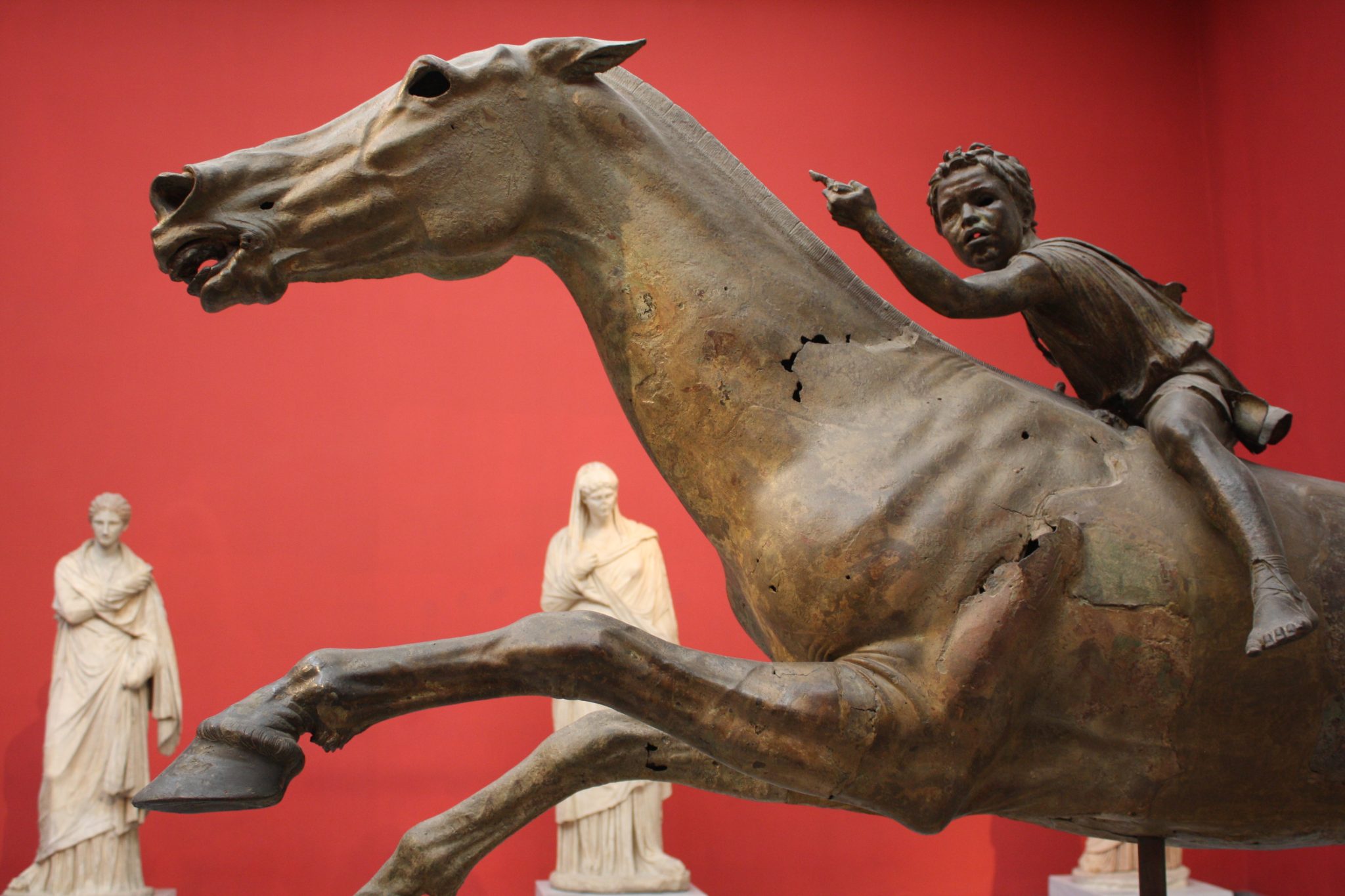The National Archaeological Museum of Athens can effortlessly lay claim to being one of the very greatest museums in the world. It can do that because it is literally jam-packed with most of the most famous art objects from ancient Greece, so much so, a first-time visit here is a strangely familiar experience. From the towering bronze Poseidon to the shimmering gold mask of Agamemnon, the antiquities on display here provide the staple images of ancient Greece; adorning guidebooks, calendars, and travel agents’ windows around the world. Familiar many of these works might be but the wow-factor is certainly no less for it. Wandering around the museum one has a constant urge to re-trace one’s steps for just one more glimpse of a stunning piece before moving on. As everything is arranged in chronological order, your tour of the museum gives you a perfect vision of the evolution of Greek art and there is even an Egyptian section as an added bonus if your senses have not already been blown away by everything on the ground floor.
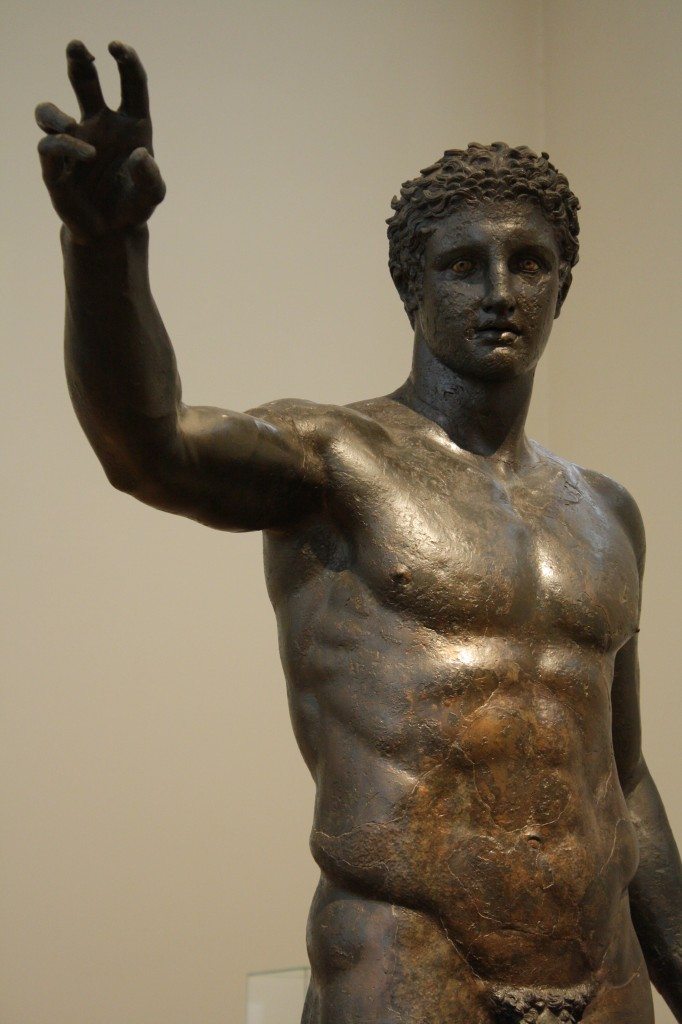
The bronze Antikythera Youth c. 340 BCE.
Located an easy 10 minute walk from Omonia metro stop, the museum is itself an impressive nod to classical architecture and is a listed building. Four massive statues of Greek gods peer down at you from the roof as if daring you not to be awestruck in the first few minutes of your visit. Once you’ve got your ticket, got rid of any large bags in the cloakroom (obligatory), and picked up your free map, you are immediately presented with the grinning mask of Agamemnon before you have even got through the first doorway. Don’t be drawn in here though by all that flashing gold but take a side-step to the room on your immediate right as here are the artefacts from the Cyclades which should come first in your odyssey through the Greek world. Pieces to look out for are the distinctive minimalist figures sculpted in marble, especially the two musical figures, one playing a harp and another an aulos (pipes), the earliest known depictions from the Greek world.
Once you have finished with the Cyclades you will find yourself back where you started and that famous mask. After you make it around the first cabinet you will be presented by an astonishing array of Mycenaean gold. On the left, on the right, and in the middle are glass cases stuffed with masks, jewellery, weapons, and cups all shimmering in the museum spotlights. Then, when you finally pull yourself away and move along, you are presented with yet more cabinets left, right, and centre, again, gold flashing everywhere in every conceivable shape from rosettes to octopuses. It is right about now that you start thinking you have already got your money’s worth and how can the museum possibly top such splendour?
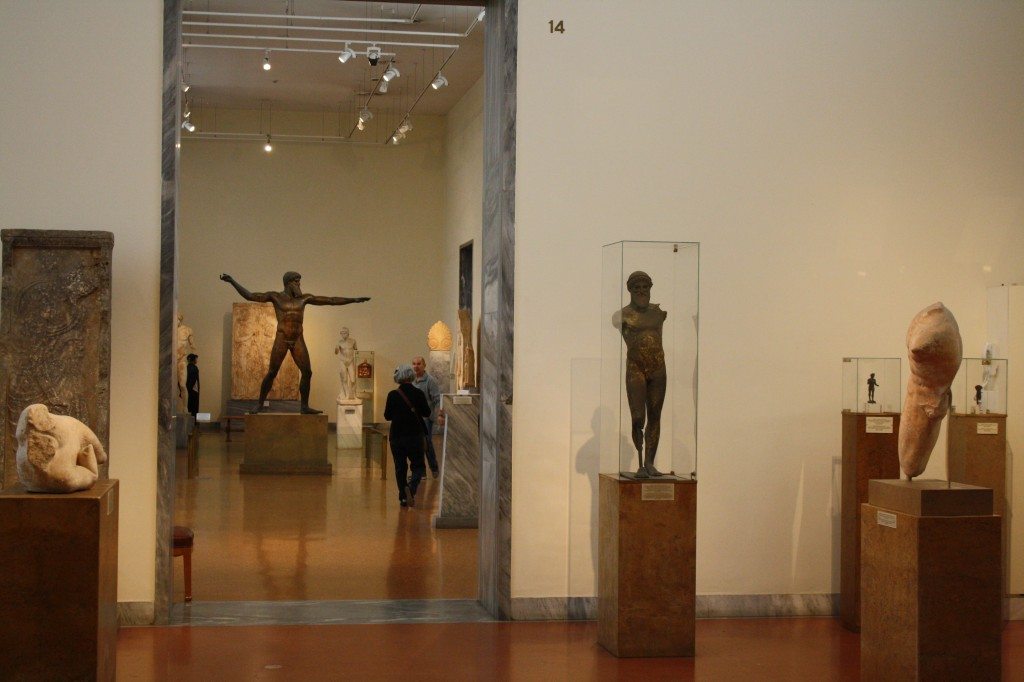
An interior view of the National Archaeological Museum, Athens.
Then you turn a corner and are presented with a massive stone kouros statue – another wow moment. The male figure presented in this way was the beginning of Greek art’s successful attempt to break the conventions of Egyptian statue figures. The arms are rigid by the sides and bring a tension to the upper body but the left leg steps forward slightly hinting at captured movement. As you walk through this section the figures become more and more life-like and dynamic as Greek sculptors became ever more daring in their efforts to render in stone the supple movement of human muscle. The best is yet to come though and the first hint is the two-metre high bronze statue of Poseidon (or maybe Zeus) rescued from the sea near Artemision. With his arms outstretched and legs braced apart he seems about to launch a trident or thunderbolt and he totally dominates the view down the hall.
Bronze was the material of choice for Greek sculptors and two more outstanding examples are the Antikythera Youth (another find from the sea) and the child jockey riding a massive horse that is captured in full gallop, so much so, it seems about to take off from its pedestal at any second. In amongst all these star pieces there are other, equally fine, marble statues of Greek gods and heroes and one of the greatest collections of funeral sculpture anywhere. As in each room, all the pieces are well-presented and each has a small info panel in Greek and English. Given their own space and unconfined by glass or barriers, the visitor can certainly get up close and personal with these 2,500 year old pieces. The sculpture continues through the Hellenistic and into the Roman period with some very familiar Roman emperors, most famously the bronze statue of a youthful Augustus.
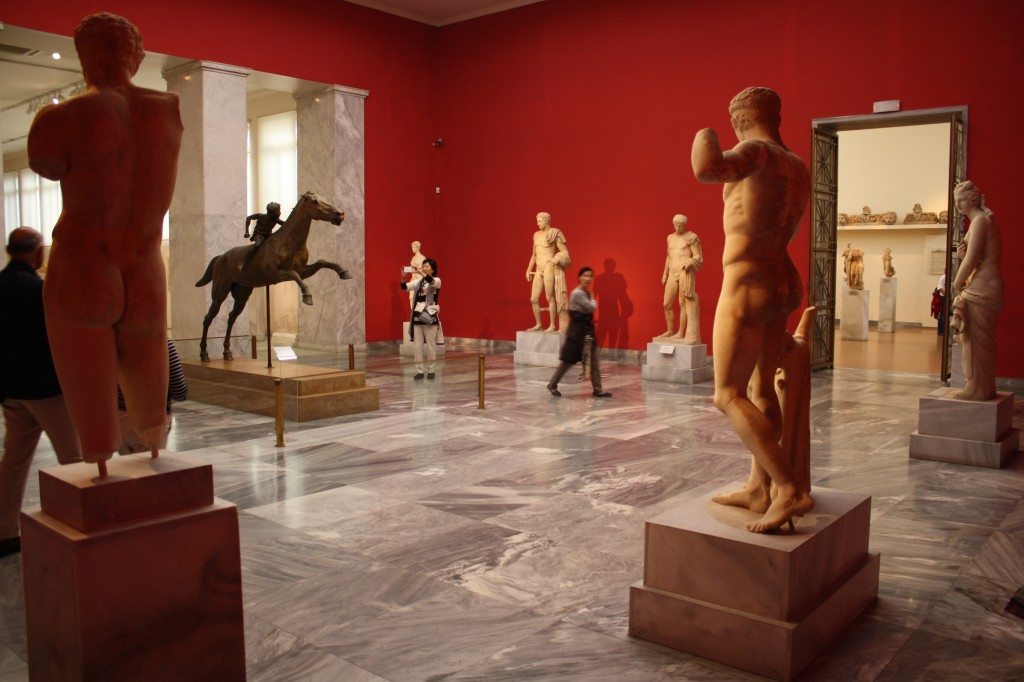
The Room of the Diadoumenos.
This is the moment when probably most visitors are feeling a bit of art-fatigue so it might be worth a break in the coffee bar in the basement where you can also buy light snacks. There is a little outside courtyard too where you can sip a Greek coffee sitting amongst ancient sculptures not deemed top drawer enough to make it into the museum proper. It is well worth pushing on though as the museum has a stupendous pottery section. As you bought your ticket you probably caught a glimpse of the huge geometric vase from the Dipylon on your left and now is the time to take a closer look. Used for funeral purposes you can see at eye-level black stick figures in mourning and burying one of their own. The amphora is perhaps the most famous example of geometric pottery design and another one of those star pieces any museum curator in the world would sell their mother for. Then there are case after case of back-figure pottery in all shapes and sizes from miniature votive vessels to huge kraters used for mixing wine and water. Next comes red-figure pottery and both of these styles are one of the most important sources of information on Greek cultural practices and mythology.
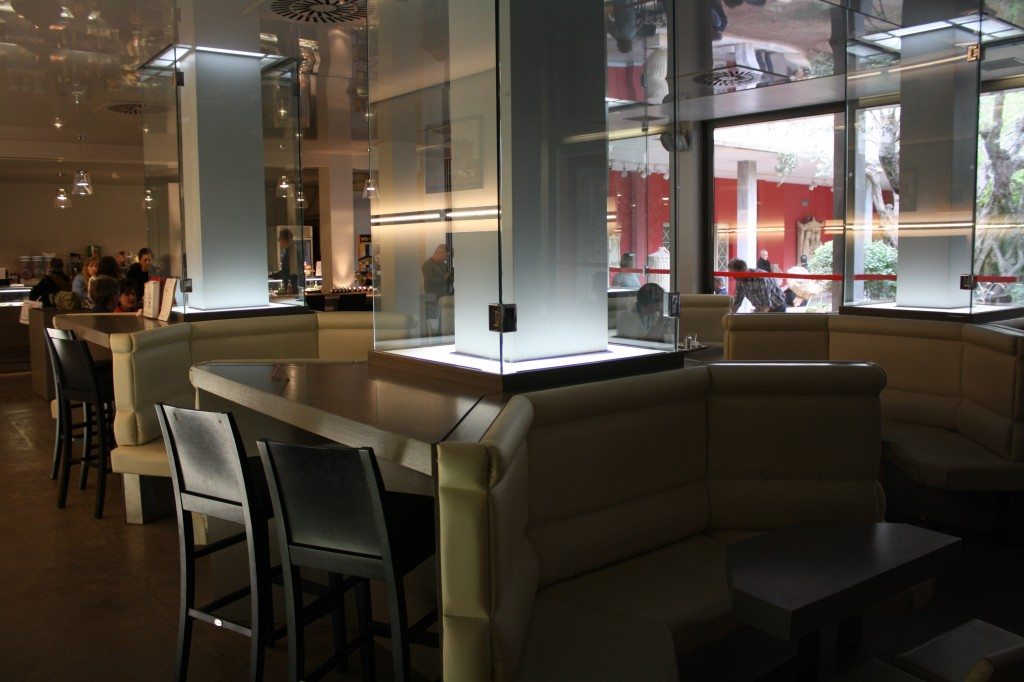
The cafe in the National Museum, Athens
Three more must-see sections are those on Thera, Egypt, and the Stathatos Collection. The first, from the Bronze Age site on Santorini, has the super-famous boxing boys fresco and three sides of a room where the fresco shows scenes of spring; there are also pottery vessels and a bed miraculously preserved in the ash following the eruption of the volcano on the island. The Egyptian section is, understandably, more modest in scope than the rest of the museum but there are still enough sarcophagi, amulets, jewellery pieces, reconstruction models, and even a mummy or two, to be of interest. Finally, the Stathatos Collection has almost a thousand exhibits and is particularly big on jewellery, including examples from the Byzantine period.
Having seen all those wonders you might fancy a keep-sake of your own and the museum shop next to the cafe has a good stock of Greek-inspired jewellery, museum-grade copies of sculpture and reliefs to suit all wallets (you can even buy life-size bronze statues, although quite how you’d get that one home…), replica coins, posters, mugs and all the other stuff anyone might want as a souvenir. There is a small collection of books on different aspects of the ancient Greeks (including plenty for children) and even some guides to other sites such as Dodona and Delphi, mostly in English or Greek.
In summary, then, even if you have visited many of the great Greek sites like the Parthenon, Knossos, and Mycenae, you cannot miss this museum for the full picture of the ancient Greeks. It really is an embarrassment of riches and one is left feeling a little sorry for some of the other Greek cities which have lost out on displaying these treasures. It is one of those museums you really should visit twice, once with your camera and once again without or just so that, on your second visit, you can keep a lid on your excitement a little better each time you see a world-famous art object around the next corner. As said above, you can get close to the art but the down-side of that is large tour groups can easily clog up the rooms so it is best to go early morning or late in the day, or even better, out of season when you pretty much get entire rooms to yourself. A wonderful, wonderful museum.
Aulos Player
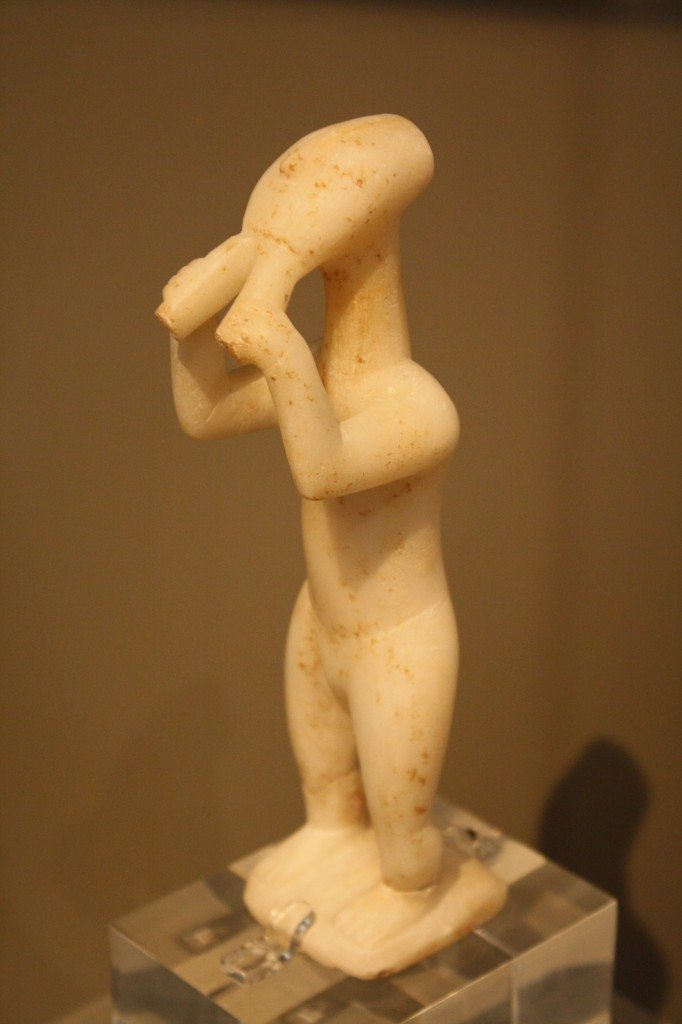
An aulos player in Parian marble, from Keros, Cyclades, 2800-2300 BCE.
Gold Octopuses
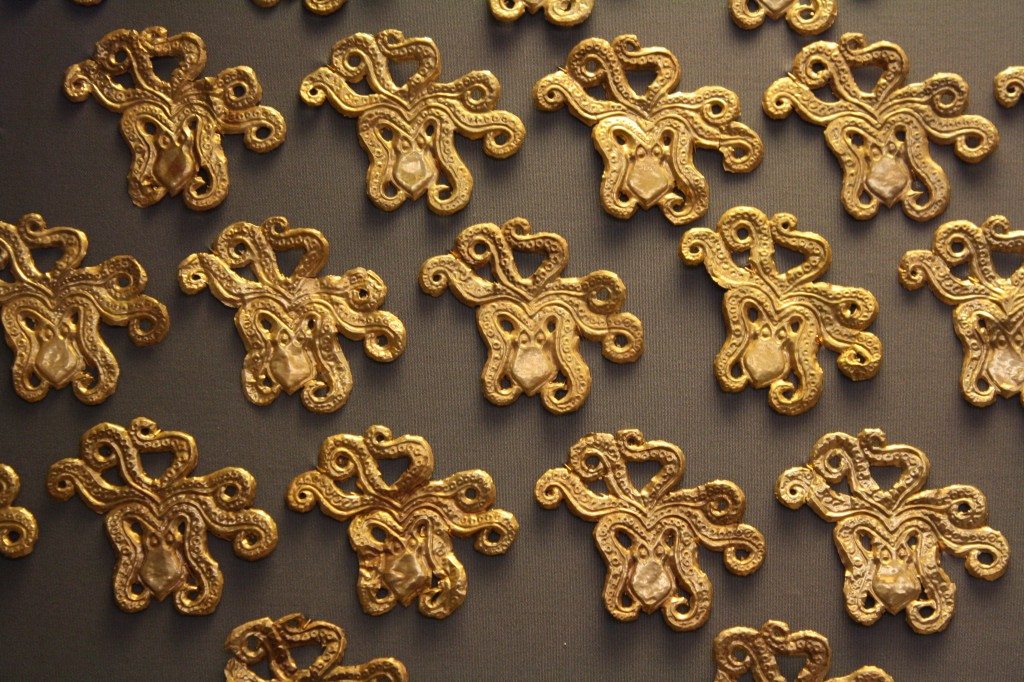
Gold cut-out octopuses, probably for textile decoration. Mycenae, 16th century BCE.
Attic Kore
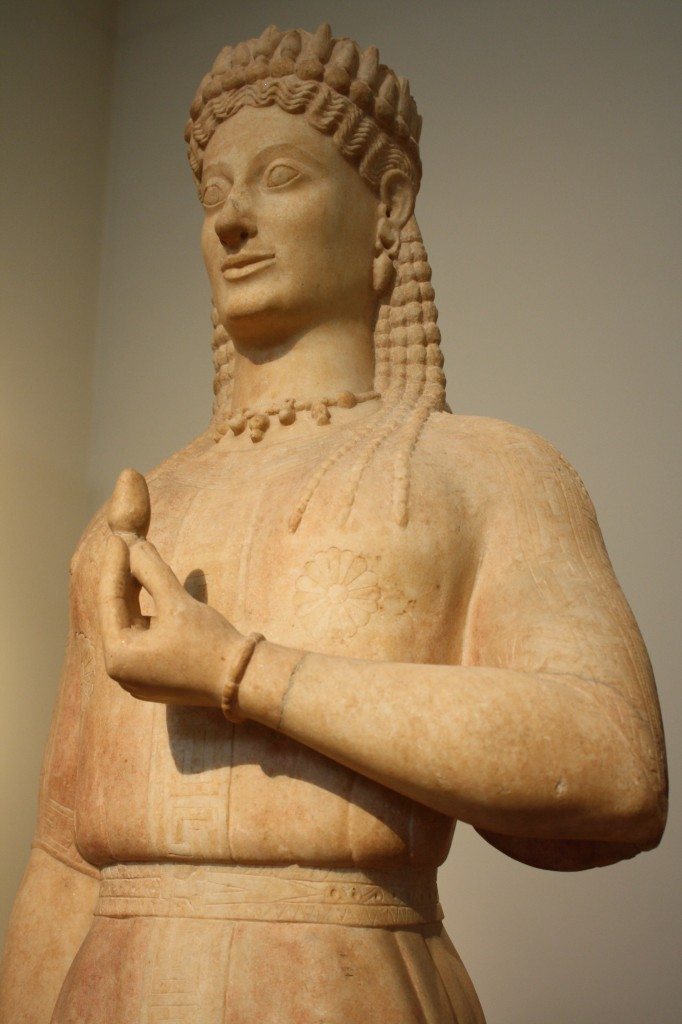
A kore from Attica, Parian marble, 550-540 BCE.
Wrestlers

A detail of a marble funerary kouros base showing two wrestlers, 510-500 BCE.
Artemision Jockey
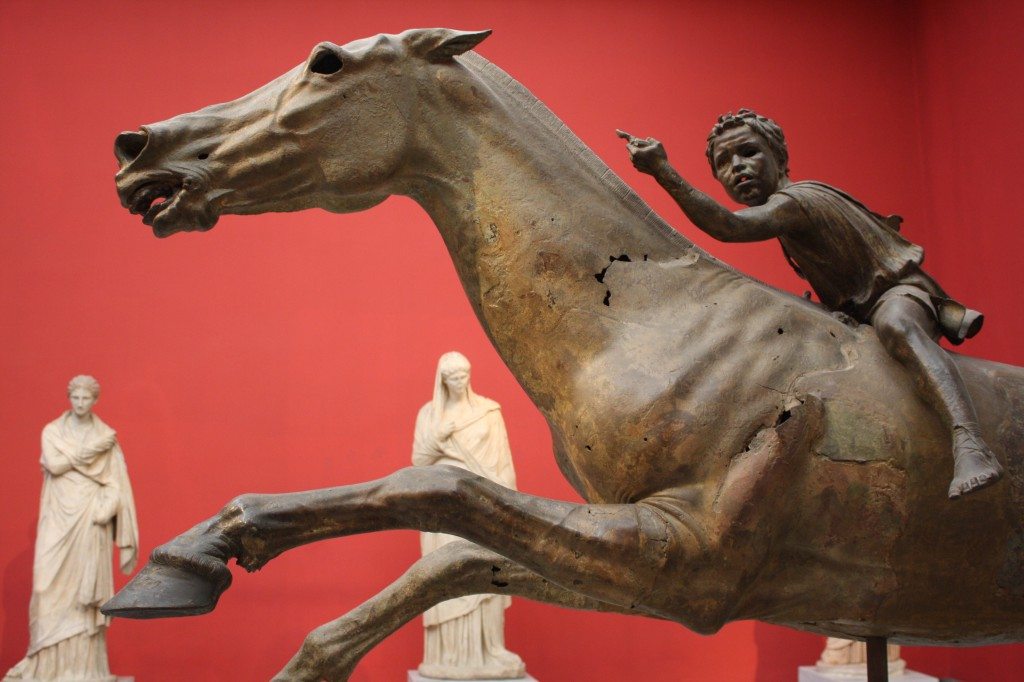
The bronze Artemision Jockey, 140 BCE.
Aphrodite
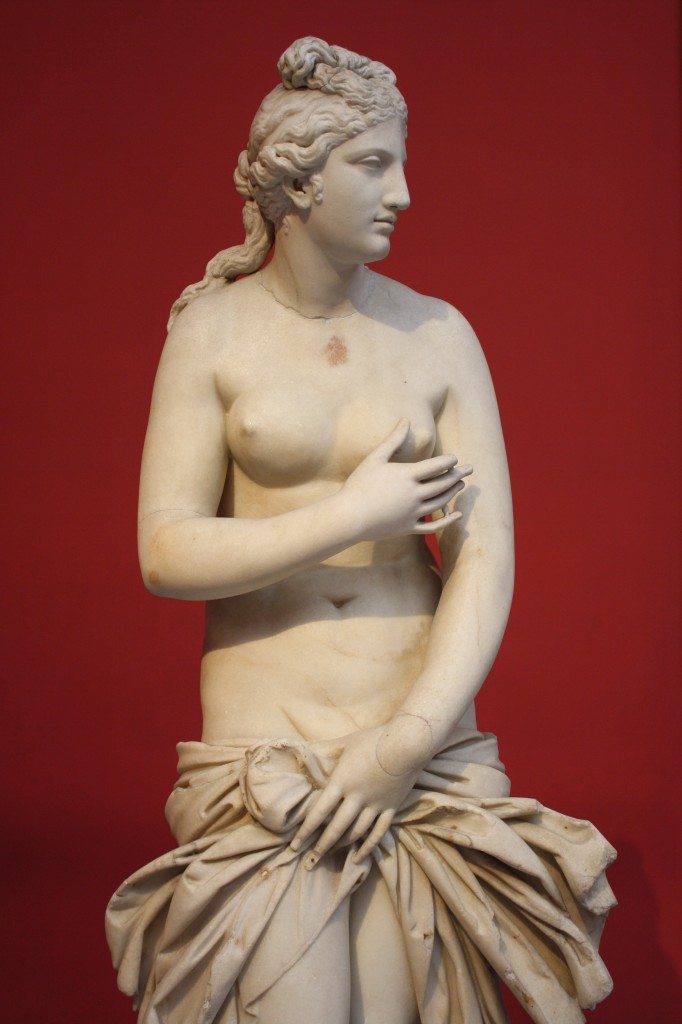
Aphrodite, Parian marble, 2nd century CE copy of a 4th century BCE original.
Bronze Athlete
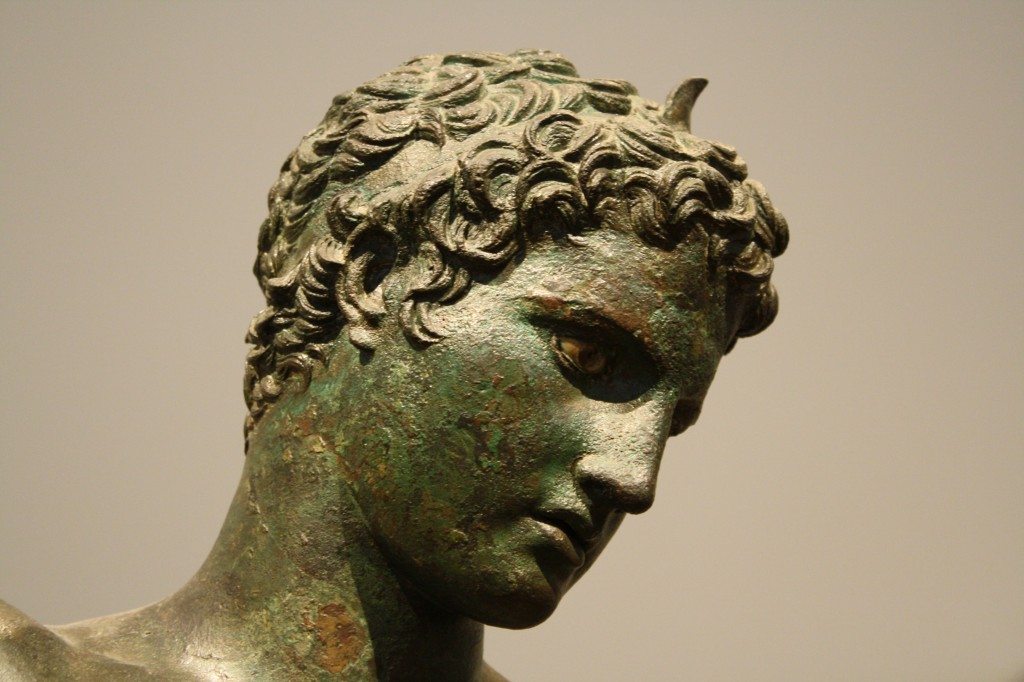
A bronze athlete, Attica, 340-330 BCE.
Emperor Augustus
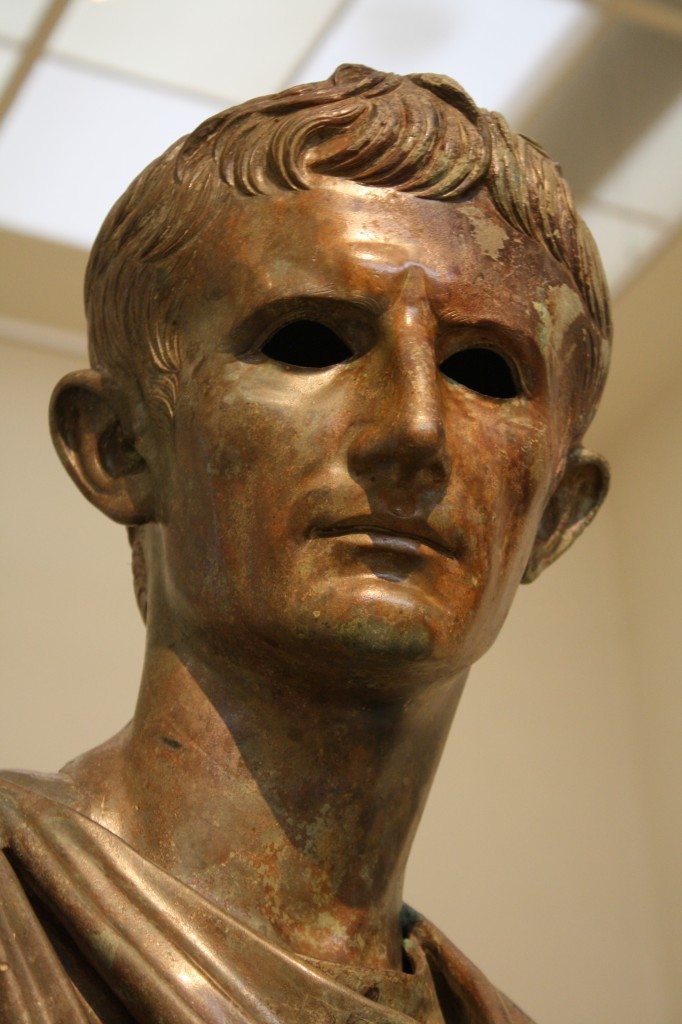
A detail of a bronze staute of Roman emperor Augustus, 12-10 BCE.
Eros and Pan
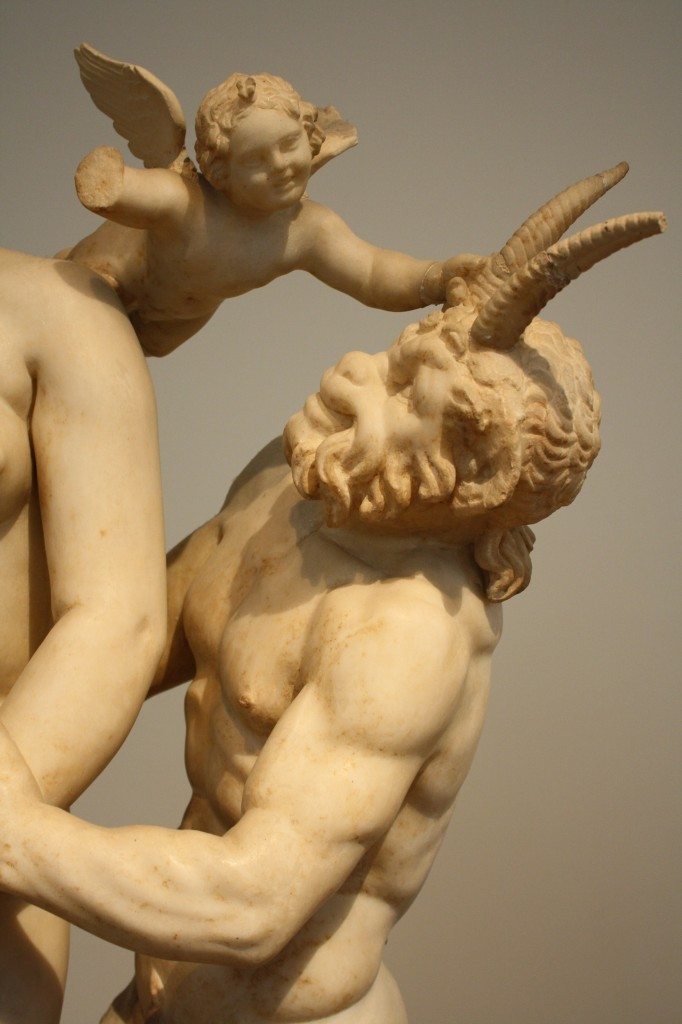
A detail of a group sculpture of Aphrodite, Eros and Pan, Parian marble, Delos, c. 100 BCE.
Thera Boxer Fresco
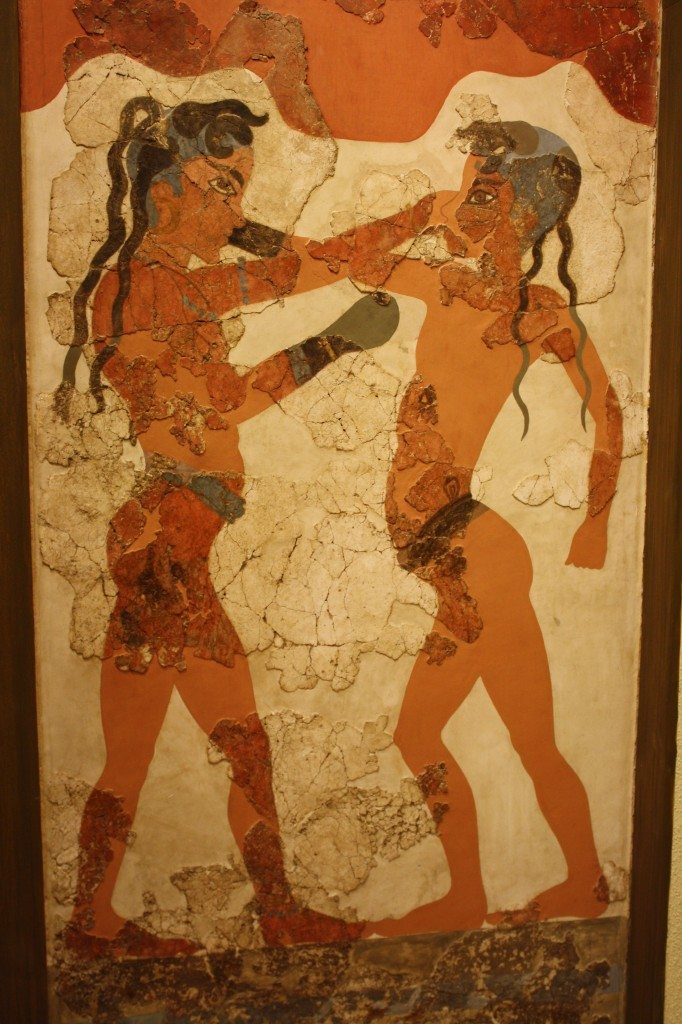
The Bronze Age Boxer Fresco from Thera.
Practicalities
Location: 44 Patision Str., Athens (Metro: Omonia)
Opening Times: Variable, see website.
Ticket Prices: 7 Euros
Museum Map: Yes, free.
Audioguide: No
Guided Tours: Yes, for individuals and groups but not included in the ticket price.
Photography: Permitted without flash.
Shop: Yes
Cafe: Yes
Cloakroom: Yes
Website: www.namuseum.gr
All images were taken by the author.
